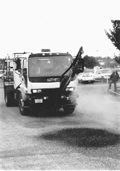U.S. Department of Transportation
Federal Highway Administration
1200 New Jersey Avenue, SE
Washington, DC 20590
202-366-4000
Focus
| Accelerating Infrastructure Innovations |
Publication Number: FHWA-RD-00-060
Date: July/August 2000
After 5 years of monitoring and evaluating 22 test sites on asphalt and concrete roads throughout the United States and Canada, the Federal Highway Administration (FHWA) has concluded that the Strategic Highway Research Program (SHRP) researchers got it right-i.e., the pavement repair materials and procedures recommended by SHRP work.
"What we found," says Charlie Churilla, head of FHWA's long-term pavement performance (LTPP) program, "is that the practices recommended in the original SHRP manuals of practice are good practices. The repairs at the test sites have held up well, validating the materials, equipment, and procedures specified in the manuals."
 |
| The updated SHRP manuals of practice provide step-by-step procedures for ensuring high-quality pothole patching and other repairs. |
Back in 1993, SHRP researchers had published a two-volume set of manuals aimed at assisting highway agencies and contractors in determining the most effective and cost-efficient means for repairing asphalt and portland cement concrete pavements. The recommendations were based on an extensive review of the literature, a nationwide survey of highway agencies, and 18 months of monitoring various types of pavement repairs made at the 22 test sites.
The monitoring ended when the SHRP esearch phase ended in late 1992. Realizing that significant knowledge could be gained through continued monitoring of the test sites, FHWA stepped in and assumed responsibility for the project in 1993, under the auspices of the LTPP program.
During the 5 years of monitoring under FHWA, teams of pavement specialists from ERES Consultants (who had also been involved in the SHRP project) conducted periodic field inspections.
"We learned that all of the materials and procedures recommended by SHRP worked well, which is not surprising because we recommended only those materials and procedures that had the best chance of succeeding," says Tom Wilson of ERES.
The manuals call for high-quality materials, if you want high-quality results. "But that doesn't mean you necessarily have to pay a lot," says Wilson. For example, the Pennsylvania Department of Transportation's specification for pothole patching materials (Penn-485) costs less than half of many proprietary products, yet holds up exceedingly well.
FHWA has updated the original SHRP reports as a series of four manuals of practice:
Each manual includes a discussion of the most appropriate time to apply a particular treatment, what types of materials and construction methods should be used, and how to evaluate the performance and cost-effectiveness of a repair procedure. Also included are step-by-step procedures for ensuring a high-quality repair and a list of sources for materials and equipment.
The four manuals of practice are available on the Web at https://www.fhwa.dot.gov/pavement/pub_listing.cfm?areas=LTPP. They can also be purchased from the National Technical Information Service at 703-605-6000 (toll free: 800-553-6847; Web: www.ntis.gov.(The original SHRP two-volume manuals are still available from the Transportation Research Board's bookstore at 202-334-3213 or www.nas.edu/trb/bookstore). For more information, contact FHWA's Bill Bellinger at 202-493-3156 (email: william.bellinger@fhwa.dot.gov).